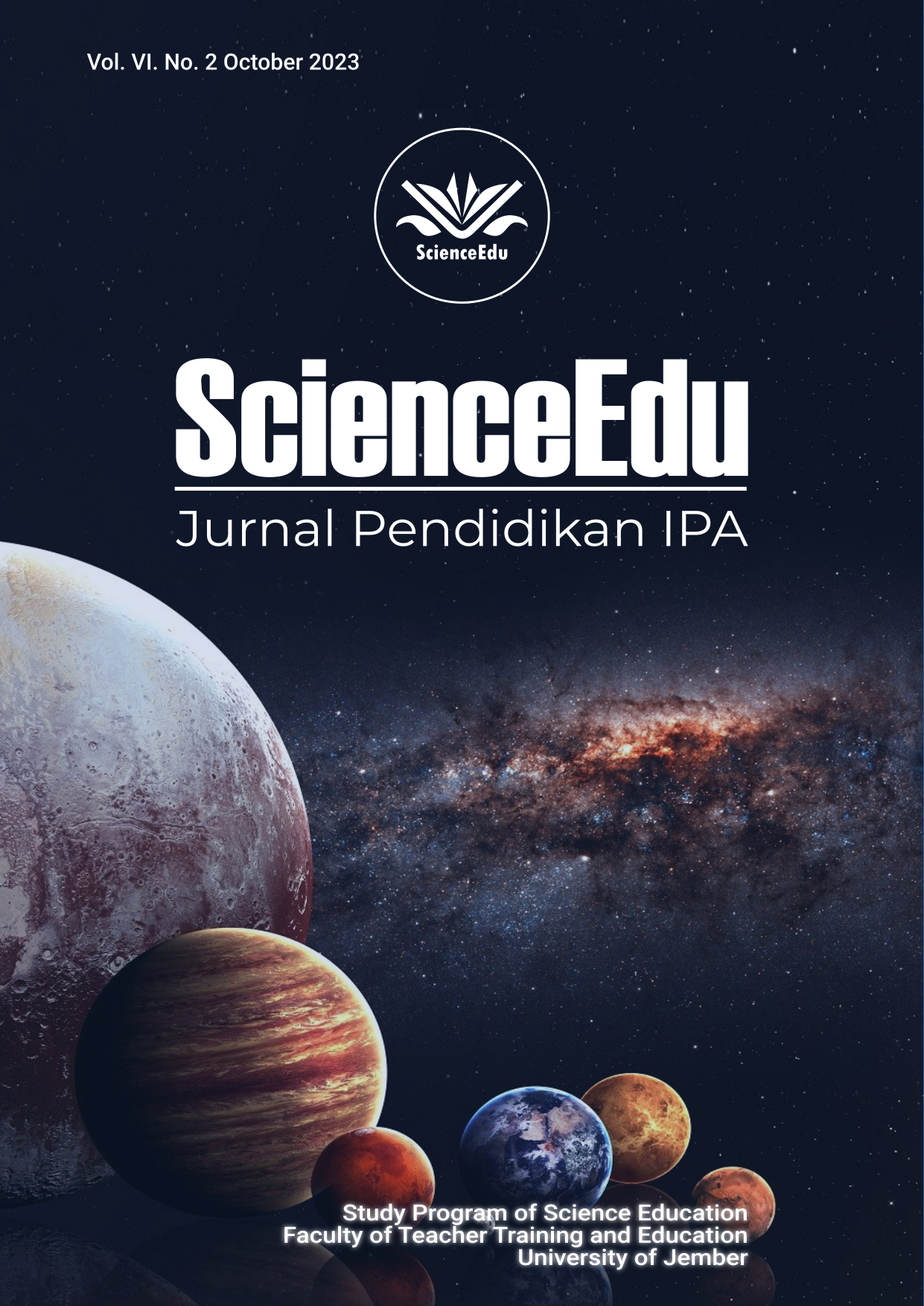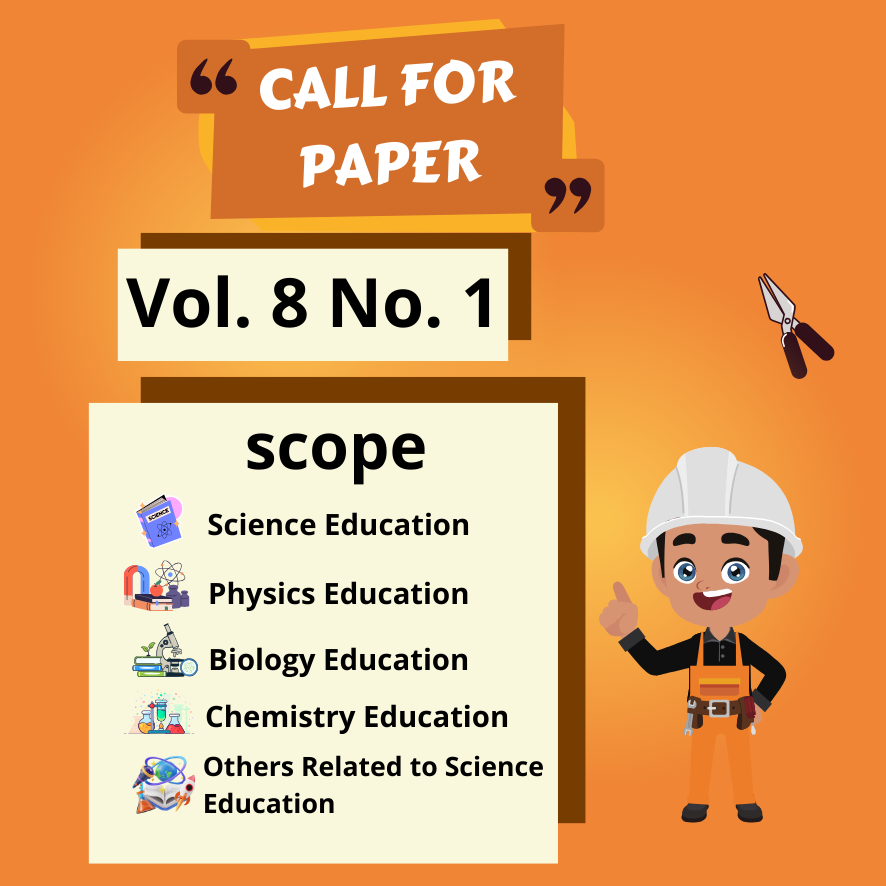PENGARUH MODEL PjBL BERBASIS STEM TERHADAP KETERAMPILAN BERPIKIR KREATIF DAN HASIL BELAJAR BIOLOGI SISWA SMA
DOI:
https://doi.org/10.19184/se.v6i2.42227Keywords:
PjBL, STEM, Berpikir KreatifAbstract
One of the skills that must be mastered by students for 21st century education is the ability to think creatively. Good creative thinking skills will improve students' cognitive learning outcomes. One way to improve this ability is by applying the PjBL’s learning model. The PjBL model’s is a learning model that involves students in carrying out a project that is useful for solving problems. The purpose of this study was to determine whether there was an effect of the PjBL based on Science, Technology, Engineering and Mathematics (STEM) learning model on Students' Thinking Ability and Learning Outcomes. Creative thinking skills and cognitive learning outcomes of students will be analyzed using the t-test. From the research results it is known that the average result of the ability to think creatively in the experimental class is 80.04, while the ability to think creatively in the control class is 70.95. Based on these data seen significance level of students' creative thinking abilities is 0.000 <0.05 so it can be concluded that there is an influence between the STEM approach to students creative thinking abilities. Based on the research results, the average difference in cognitive learning outcomes in the experimental class was 31.89, while the average difference in learning outcomes in the control class was 20.17. Based on these data it is known that the results of the Anakova test analysis show a significance level of 0.000 <0.05, which means that there is an influence of the STEM and learning model based on PjBL’s on student learning outcomes.
Downloads
References
Aripin, Ipin., Muhamad K, S., Iim, H, M., Asep Mulyani. 2020. Pembekalan Kompetensi Guru Biologi melalui Kegiatan Pelatihan Pembelajaran Biologi Abad-21. Jurnal Pengabdian Kepada Masyarakat. 1(3): 150-158.
Awaliyah, C.R. (2016). Implementasi Model PjBL dengan Pendekatan STEM untuk Mengingkatkan Penguasaan Konsep dan Kreativitas pada Siswa SMP pada Materi Ekosistem. Tesis, SPS UPI.
Daugherty, M. K. 2013. The Prospect of an" A" in STEM Education. Journal of STEM Education: Innovations and Research. 14(2).
Fitria, Y. 2017. Efektifitas Capaian Kompetensi Belajar Siswa dalam Pembelajaran Sains di Sekolah Dasar. Jurnal Inovasi Pendidikan dan Pembelajaran Sekolah Dasar. 1(2): 34-42.
Ismiati, I. 2020. Pembelajaran Biologi SMA Abad ke-21 Berbasis Potensi Lokal: Review Potensi di Kabupaten Nunukan-Kalimantan Utara. Jurnal Penelitian dan Pengkajian Ilmu Pendidikan: e-Saintika. 4(2): 234-247.
Kemendikbud. 2016. Kementerian Pendidikan dan Kebudayaan. Direktorat Jenderal Pendidikan Dasar Menengah, Direktorat Pembinaan Sekolah Dasar.
Kemendikbud. 2017. Buku Guru Ilmu Pengetahuan Alam. Jakarta: PT.Tiga Serangkai Pustaka Mandiri.
Kristiani, K, D., Mayasari, T., & Kurniadi, E. 2017. Pengaruh Pembelajaran STEM-PjBL terhadap Keterampilan Berpikir Kreatif. Prosiding SNPF (Seminar Nasional Pendidikan Fisika). 266-274.
Nur, Iyan. R. D. 2016. Meningkatkan keterampilan berpikir kreatif Matematis dan Kemandirian Belajar Siswa dengan Menggunakan Model Pembelajaran Brain Based Learning. Jurnal pendidikan Unsika. 4(1): 26-41.
Nurfaijah, S., W. Sumarni, S. S. Sumarti, dan C. Kurniawan. 2021. Pengaruh Project Based Learning Terintegrasi STEM Pada Pembelajaran Hidrolisis Garam Terhadap Keaktifan Siswa. Chemistry in Education. 10(2): 33-41
Syarah, M, M., Rahmi, Y. L., & Darussyamsu, R. 2021. Analisis Penerapan Pendekatan STEM pada Pembelajaran Biologi. BIO-EDU: Jurnal Pendidikan Biologi. 6(3): 236-243.
Uno., Nurdin. 2014. Belajar dengan Pendekatan PAILKEM. Jakarta: Bumi Aksara
Wahono, B., Lin, P. L., & Chang, C. Y. (2020). Evidence of STEM enactment effectiveness in Asian student learning outcomes. International Journal of STEM Education, 7(1), 1–18. https://doi.org/10.1186/s40594-020-00236-1
Wahono, B., Narulita, E., Chang, C. Y., Darmawan, E., & Irwanto, I. (2021). The Role of Students’ Worldview on Decision-Making: An Indonesian Case Study by a Socio-Scientific Issue-Based2 Instruction Through Integrated STEM Education. Eurasia Journal of Mathematics, Science and Technology Education, 17(11), 1–15.https://doi.org/10.29333/ejmste/11246



